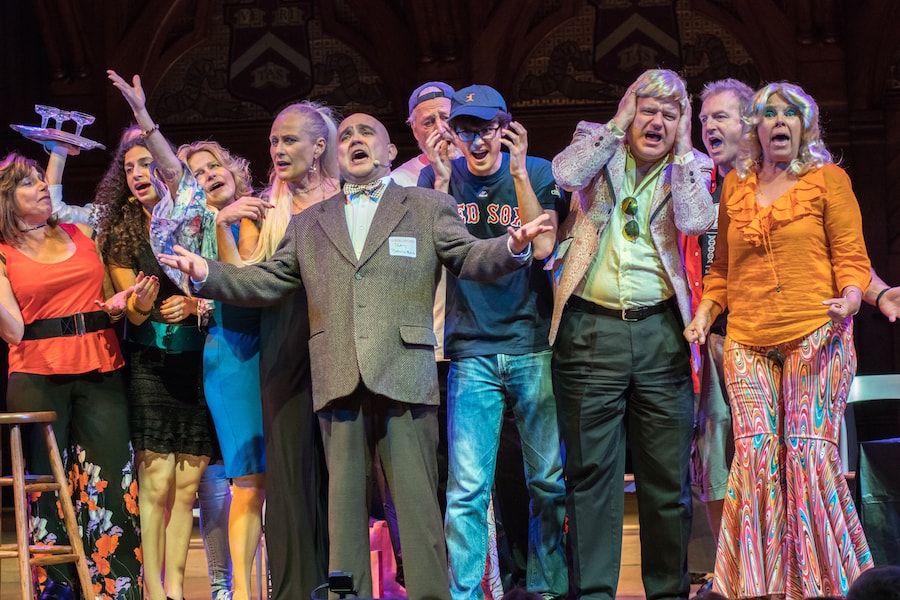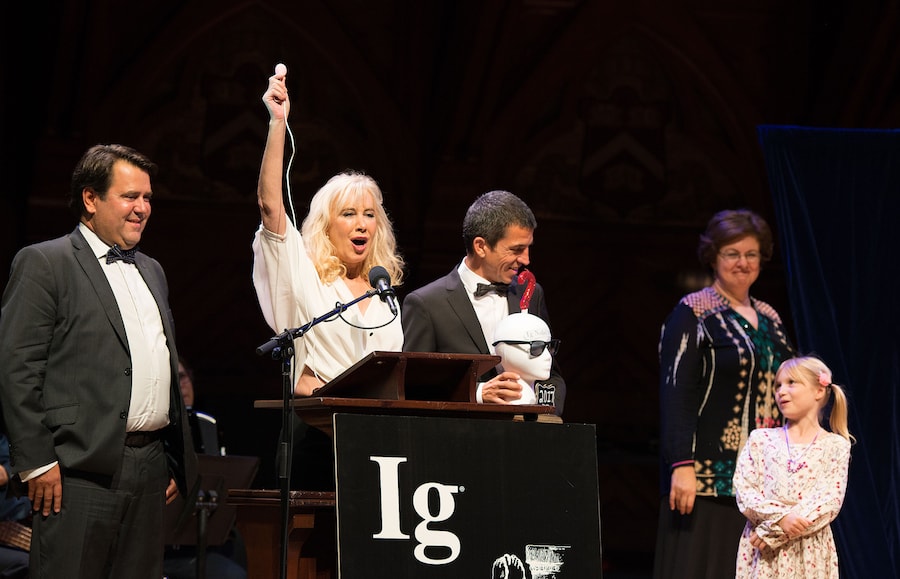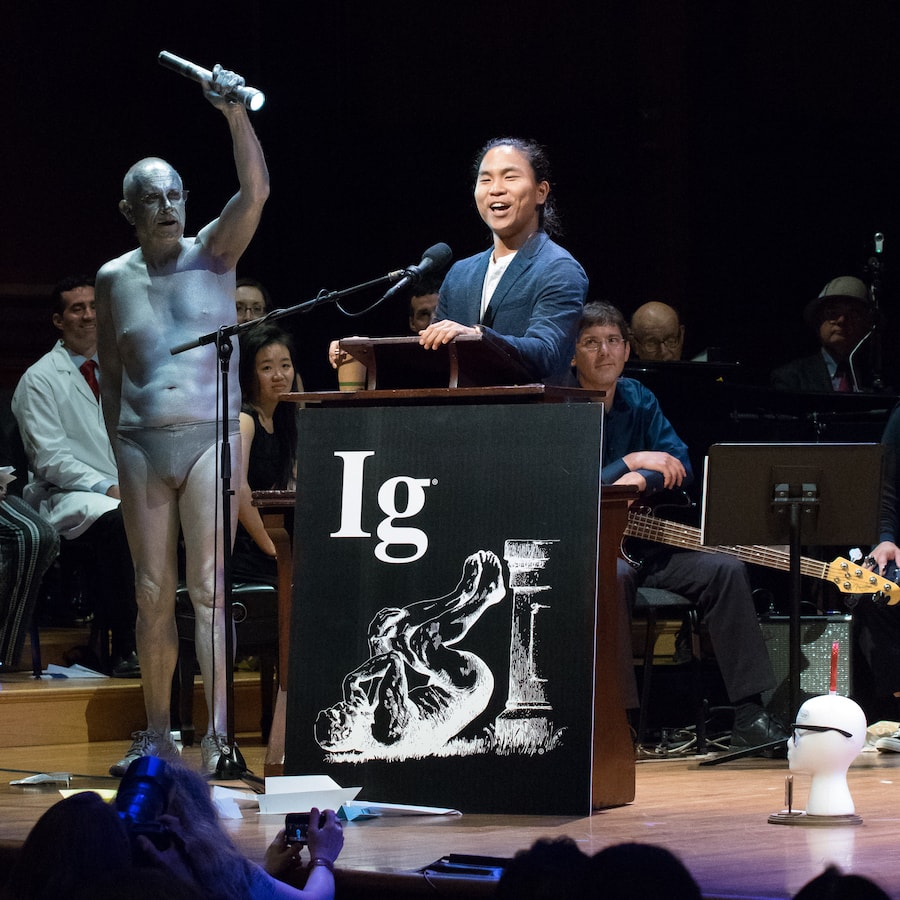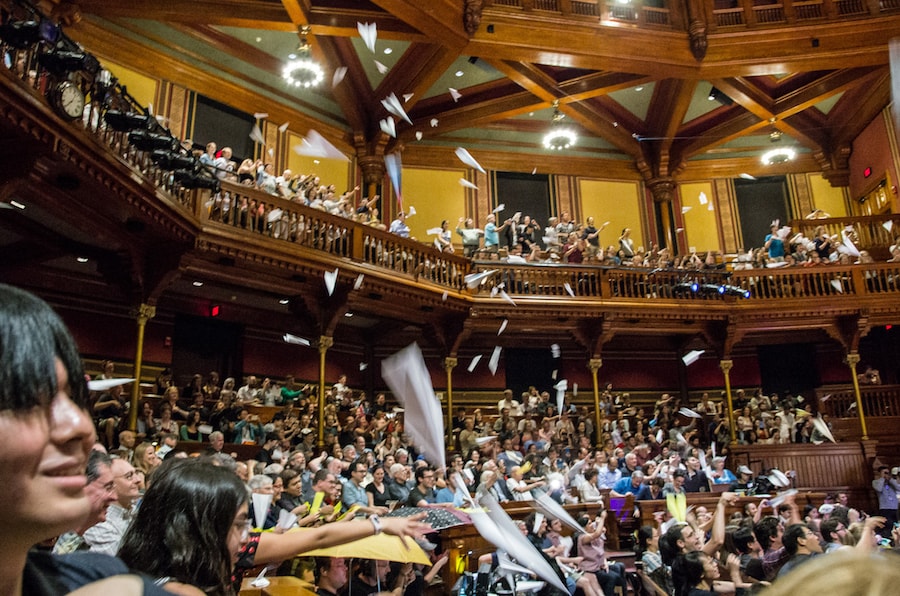From Cat Rheology To Operatic Incompetence
47:37 minutes

Can playing the didjeridoo affect your sleep apnea? Why do many old men seem to have really big ears? And can a modern brain scan tell us anything about people who find cheese disgusting?
[Need to communicate some science? Alan Alda has some pointers.]
In this hour of Science Friday, we’ll pay a visit to the 27th First Annual Ig Nobel Prize ceremonies, recorded in September on the Harvard campus. The awards ceremony, organized by the science humor magazine the Annals Of Improbable Research, honors the strange and silly in the world of science. The work presented, in the words of editor Marc Abrahams, “first makes you laugh, and then makes you think.”




Marc Abrahams is the editor and co-founder of Annals of Improbable Research and the founder and master of ceremonies for the Ig Nobel Awards Ceremony in Cambridge, Massachusetts.
IRA FLATOW: This is Science Friday. I’m Ira Flatow. We’re glad you’re with us today, whether out shopping, catching up on some relaxation, or thinking about having another turkey sandwich. Here at Science Friday, the day after Thanksgiving, as you know is our own kind of holiday tradition, highlights from this year’s Ig Nobel Awards ceremony. The awards are handed out each year by the editors of the Science Humor Magazine, the Annals of Improbable Research, for work and science that first makes you laugh and then makes you think, like studying the physics of how the coffee in your cup moves if you’re walking backwards.
We’re looking into the differences in force required to drag a sheep across various surfaces. This year’s celebration is the 27th first annual awards. This year’s ceremonies featured a mini opera about the psychology of incompetence and prizes handed out by genuine regular Nobel laureates.
The theme for this year was uncertainty. You’ll hear the audience cheer whenever that word is mentioned and special lectures about Heisenberg and his uncertainty principle. But one thing is certain, you should grab a comfy chair and let us take you back to earlier this year at Harvard Sanders Theater, where the dignitaries and igntitaries are taking the stage.
SPEAKER 1: T minus 5, 4, 3, 2– wait! I almost forgot. Welcome to the 27th first annual Ig Nobel Prize ceremony. 5, 4, 3, 2, 1. Go!
IRA FLATOW: The awards are presented by the editors of the Annals of Improbable Research you can find out more about them at improbable.com. This year marks the 27th first annual Ig Nobel awards. Happy anniversary.
There’s a little girl on hand at the ceremonies to help make sure things are– well, how shall we say, running on time. You’ll here Miss Sweetie-Poo start to whine whenever the speakers go on too long.
SPEAKER 1: Ladies and gentlemen, knowers, doubters, and people comfortable with uncertainty, welcome to the 27th first annual Ig Nobel Prize ceremony. And now, Professor Jean Berko Gleason will deliver the traditional Ig Nobel welcome welcome speech.
JEAN BERKO GLEASON: Welcome. Welcome.
SPEAKER 1: And now, ladies and gentlemen, boys and girls, literati, glitterati, pseudo intellectuals, quasi pseudo intellectuals, and the rest of you, may I introduce our Master of Ceremonies, the editor of the Annals of Improbable Research, Chief Airhead, Marc Abrahams.
MARC ABRAHAMS: We are gathered here tonight to honor some remarkable individuals and groups. Each winner has done something that makes people laugh then think. The Ig Nobel Prize ceremony is produced by the Science Humor Magazine the Annals of Improbable Research, and it’s co-sponsored proudly by the Harvard-Radcliffe Society of Physics Students and the Harvard-Radcliffe Science Fiction Association and by the book This is Improbable Too, ISBN 9781780743615.
The editors of the Annals of Improbable Research have chosen a theme for this year’s ceremony. That theme, I think, is uncertainty. Is that right? The prizes will be physically presented to the new Ig Nobel Prize winners by Nobel laureates.
Ladies and gentlemen, please welcome the Nobel laureates. 2007 Nobel laureate in economics, Eric Maskin; 2016 Nobel laureate in economics, Oliver Hart; 2005 Nobel laureate in physics and a man who for two decades has humbly swept paper airplanes from this stage at this ceremony, Roy Glauber; and 1990 Nobel laureate in physics from MIT, Jerome Friedman. As usual was prevented from joining us, but he appears now via the magic of video.
JEROME FRIEDMAN: Congratulations. I hope you are enjoying this as much as I am.
MARC ABRAHAMS: Thank you, Professor Friedman. The key note address, tonight’s very brief keynote address will be given by Jean Evans. The topic of this keynote address is, Heisenberg Uncertainty.
JEAN EVANS: The Heisenberg Uncertainty Principle is very famous, you know. It was named after Werner Heisenberg, the German physicist who thought it up. That was in 1927. 55 years later in 1982, I was in Lindau, Germany at a scientific conference. There were Nobel laureates, students, and invited guests. We were all sitting at long tables and directly across from me were two Nobel laureates. One was Dorothy Hodgkin from Oxford and my husband, Bill Lipscomb from Harvard.
Soon a very elegant lady, older lady, showed up at our table and sat down right next to me. She leaned in and said, my name is Mrs. Heisenberg. My husband looked up. Are you certain?
MARC ABRAHAMS: Now get set for something special, the 24/7 lectures. We’ve invited several of the world’s top thinkers to tell us very briefly what they’re thinking about. Each 24/7 lecturer will explain her or his subject twice, first a complete technical description in 24 seconds. And then after a brief pause, a clear summary that anyone can understand in seven words.
Our referee, Mr. John Barrett, has joined us. He will enforce the 24 second time limit. Mr. Barrett, do you have any advice for our 24/7 lecturers?
JOHN BARRETT: Gentlemen, keep it clean.
MARC ABRAHAMS: Thank you, Mr. Barrett. The first 24/7 lecture will be delivered by a professor of artificial intelligence and the philosophy of technology at Kozminski University in Poland. Please welcome Alexandra Przegalinska. Her topic, bots. First, a complete technical description of the subject in 24 seconds. On your mark, get set, go.
ALEXANDRA PRZEGALINSKA: We presented a study of human bot interaction based on an experiment that consisted of two parts, measurements of physiological reaction to chat bot users and the questioner that focused on assessing willingness to talk to a robot or chat bot. Our particular focus was on uncanny valley effect. And in the experiment, we juxtaposed the EDA channel with a digital input channel, and the data indicated a very strong positive correlation between the uncanny valley effect and the negative evaluation.
MARC ABRAHAMS: And now a clear summary that anyone can understand in seven words. On your mark, get set, go.
ALEXANDRA PRZEGALINSKA: Robots that talk are perceived as stupid. Sorry.
MARC ABRAHAMS: The next 24/7 lecture will be delivered by the Nobel Prize winning economist, Eric Maskin. His topic, uncertainty. First, a complete technical description of the subject in 24 seconds. On your mark, get set, go.
ERIC MASKIN: Uncertainty is the heart of economic life. What do oil men, poker players, and bond traders have in common? Oil men drill their wells, poker players look for tells, and traders time their sells in order to exploit other people’s uncertainty. A party who does this well earns a profit, and the other parties will cry if they want to.
MARC ABRAHAMS: And now, a clear summary that anyone can understand in seven words. On your mark, get set, go.
ERIC MASKIN: Uncertainty is the only sure thing. Perhaps.
IRA FLATOW: We’re going to take a break. Here’s a sample of this year’s pre-ceremony concert by the Boston Typewriter Orchestra.
Coming up, more highlights from this year’s 27th first annual Ig Nobel awards. Stay with us.
This is Science Friday. I’m Ira Flatow, and if you’re just joining us, we’re playing highlights from this year’s Ig Nobel Awards ceremony, research that first makes you laugh, then makes you think. It was recorded in September of this year at Harvard’s Sanders Theater. Here is Master of Ceremonies, Marc Abrahams.
MARC ABRAHAMS: All right. Let’s get it over with. Ladies and gentlemen, the awarding of the 2017 Ig Nobel prizes. The winners this year have truly earned their prizes. Karen, tell them what they win.
KAREN HOPKIN: This year’s winners will each receive an Ig Nobel Prize.
MARC ABRAHAMS: What else will they get?
KAREN HOPKIN: A piece of paper saying they’ve won an Ig Nobel Prize. It’s actually signed by several Nobel laureates.
MARC ABRAHAMS: Do they get any money?
KAREN HOPKIN: $10 trillion.
MARC ABRAHAMS: $10 trillion?
KAREN HOPKIN: $10 trillion.
MARC ABRAHAMS: Trillion?
KAREN HOPKIN: $10 trillion.
MARC ABRAHAMS: US dollars.
KAREN HOPKIN: Zimbabwean dollars.
MARC ABRAHAMS: Zimbabwean dollars.
KAREN HOPKIN: We’re talking about a Zimbabwean $10 trillion bill.
MARC ABRAHAMS: That’s all?
KAREN HOPKIN: Yes, that’s all.
MARC ABRAHAMS: How nice. Thank you, Karen. Ladies and gentlemen, this is the coveted Ig Nobel Prize. This year’s prize is a replica of a human head supporting a replica of a question mark.
The physics prize. The winners come from France, Singapore, and the USA. This year’s physics prize is awarded to Marc-Antoine Fardin for using fluid dynamics to probe the question, can a cat be both a solid and a liquid? Please welcome our winner.
MARC-ANTOINE FARDIN: Thank you. So are cats liquid? So this question asked on the internet. And it was based on the common definition that a liquid is a material that can adapt its shape to its container, and it seems to be the case.
So I couldn’t refrain from using this question as a way to highlight some of the actual questions and problems that are studied in rheology. So rheology is the study of flows from the Greek rheo, to flow. You can find the same Greek roots in the word diarrhea, so you know it’s serious. And you can also find it in the more sophisticated word, logorrhea, so I’ll keep this short.
So basically, what I said in the paper is that–
MISS SWEETIE-POO: Please stop. I’m bored. Please stop. I’m bored.
MARC-ANTOINE FARDIN: Thank you, Miss Sweetie-Poo.
MARC ABRAHAMS: Thank you. You can collect your $10 trillion from the Nobel laureates over there. The Peace Prize. The winners are from Switzerland, Canada, the Netherlands and the USA. This year’s Ig Nobel Peace Prize is awarded to Milo Puhan, Alex Suarez, Christian Lo Cascio, Alfred Zahn, Markus Heitz, and Otto Braendli for demonstrating that regular playing of a didgeridoo is an effective treatment for obstructive sleep apnea and snoring.
Please welcome the winners.
[APPLAUSE]
SPEAKER 2: This is Alex. This is Alex Suarez, and he himself suffered 15 years ago from obstructive sleep apnea syndrome. And got prescribed the usual treatment, which is the mask treatment. Well, he went home, came back after a while and said, oh, I much better. But I didn’t use to mask. I didn’t tolerate the mask. It was nothing for me, but I pick up playing the didgeridoo with a special breathing technique, and indeed, the sleep apnea syndrome was gone.
And he helped other patients do the same and after a while, we thought yeah, let’s do a study on this. And we did the randomized trial, and this trial showed, actually, that after four months of playing the didgeridoo five times a week that it reduces daytime sleepiness, the main symptoms, snoring, and apneas during sleep.
And this actually showed that the sleep apnea may be treated by this exercise-based active type of treatment, which was kind of a proof of concept study. So we are very happy to receive this honor, this prize. And I can also tell you about another study.
MISS SWEETIE-POO: Please stop. I’m bored. Please stop. I’m bored. Please stop. I’m bored.
MARC ABRAHAMS: The economics prize. The winners are from Australia and the USA. This year’s Ig Nobel economics prize is awarded to Matthew Rockloff and Nancy Greer for their experiments to see how contacts with a live crocodile affects a person’s willingness to gamble. Please welcome the winners.
MATTHEW ROCKLOFF: I have to rush up here. I don’t have long. Good day. Let’s try it again. Good day.
AUDIENCE: Good day.
MATTHEW ROCKLOFF: Excellent. That’s what I want to hear.
NANCY GREER: Matt, that’s not an Aussie accent.
MATTHEW ROCKLOFF: I’m sorry. Yeah, she’s got the real Aussie accent. Sorry about that. So I don’t do it very well. But anyway I wanted to thank everybody for giving us this prize. I’d like, in particular, to thank my family.
My wife who said that when I ask what’s exciting central Queensland we can use to motivate people to gamble, she said, well, crocodiles were chockablock with crocodiles. So that’s what we used. And I wanted to also think Nancy who actually did all the work on this project. Went on 100 tours, and had a croc pies. And Nancy had a few words to say.
NANCY GREER: And I got to hold a crocodile.
MATTHEW ROCKLOFF: Over here.
NANCY GREER: And I got to hold a crocodile. Thanks, Matt, for giving me my first research job, and thank to you my family, my partner, my friends for supporting me in my research ventures.
MARC ABRAHAMS: The anatomy prize. The winner is from the UK. The Ig Nobel anatomy prize is awarded this year to James Heathcote for his medical research study, “Why Do Old Men Have Big Ears?” Please welcome the winner.
JAMES HEATHCOTE: Thank you. High. Thank you very much. Have you ever sat on a bus and noticed that the old man opposite you has very big ears? Once you’ve spotted it, it is impossible to imagine those enormous ears on a younger man. And so they must have grown.
20 years ago we set out to prove this by measuring the ears of 206 patients. And we put it on a graph, and it’s true. On average, your ears grow by about 2 millimeters a decade. Thank you for inviting me tonight. For everyone who’s helped me to get this ear-shattering piece of research completed and published. Make of it what you will. Thank you.
MARC ABRAHAMS: Don’t forget. Don’t forget. Don’t forget to collect your $10 trillion bill over there. The second and final round of the 24/7 lectures is about to begin. The next 24/7 lecture will be delivered by the head of the Henske Lab at Harvard Medical School and Brigham and Women’s Hospital, Elizabeth Henske.
Her topic, biomedical research. First, complete technical description of the subject in 24 seconds. On your mark, get set, go.
ELIZABETH HENSKE: My medical research is the investigation of health and disease by physicians and scientists worldwide, partnering with patients, driven by data, and seeking to prevent treating cure devastating diseases like AIDS, cancer, diabetes, leukemia, lupus, parasitic disease, tuberous sclerosis and lymphangioleiomyomatosis using tools including genetics, genomics, epigenomics, metagenomics, proteomics, metabolomics, high throughput screens, and phase 1, 2, and 3 clinical trials.
MARC ABRAHAMS: And now, a clear summary that anyone can understand in seven words. On your mark, get set, go.
ELIZABETH HENSKE: Biomedical research is good for your health.
MARC ABRAHAMS: The next 24/7 lecture will be delivered by a specialist in occupational health and safety and human factors engineering in Victoria, Australia. And he’s the winner of the 2000 Ig Nobel Prize in physics for coauthoring the study and analysis of “The Forces Required to Drag Sheep Over Various Surfaces.” John Culvenor.
Dr. Culvenor’s topic, “The Forces Required to Drag Sheep Over Various Surfaces.” First, a complete technical description of the subject in 24 seconds. On your mark, get set, go.
JOHN CULVENOR: Greetings, folks. The title of the speech is rejoice. Rejoice. After searching all night, it was there in the light. Hey, mate, the sheep, what a wonderful sight. So woolly, so bright. But what here, [? Coba, ?] that jump box, not light. It is not slight. You must drag it from a height. Remember–
MARC ABRAHAMS: And now a clear summary that anyone can understand in seven words. On your mark, get set, go.
JOHN CULVENOR: Newton was right. Eat apples and Vegemite.
MARC ABRAHAMS: Thank you. The final 24/7 lecture will be delivered by a researcher at the Smithsonian Institution’s department of invertebrate zoology, Alicia Perez-Porro. Her topic, sponges. First, a complete technical description of the subject in 24 seconds. On your mark, get set, go.
ALICIA PEREZ-PORRO: Marina sponges are sessile filter feeder vertebrates at the base of Metazoan’s evolutionary tree. They have a key role in marine ecosystems and different levels of resiliency to climate change. Because of this, some reefs have been reportedly switching from coral to sponge dominated. I use genomic techniques to reveal the genetic toolkit behind acclimation to climate change in [INAUDIBLE] sponges.
MARC ABRAHAMS: And now a clear summary that anyone can understand in seven words. On your mark, get set, go.
ALICIA PEREZ-PORRO: Our earliest animal ancestors are marine sponges.
IRA FLATOW: I’m Ira Flatow, and this is Science Friday from PRI, Public Radio International.
MARC ABRAHAMS: Now, onto something new and intellectually stimulating, the first ever win an empty box contest. Some lucky member of the audience here in historic Sanders Theater will win an empty box.
This, ladies and gentlemen, is an empty box. And what better way to attest to the fact that it’s an empty box and to minimize any uncertainty, than to ask Nobel laureate, Eric Maskin, to examine the object and tell us whether it is or is not an empty box.
Professor Maskin, we handed you this object. Please tell us whether, in your opinion, this is an empty box.
ERIC MASKIN: It’s an empty box.
MARC ABRAHAMS: All right. Thank you. Now, let’s see which lucky ticket holder will win this empty box. When you entered the theater earlier, you were handed an attractive printed program. Open that program up right now. Turn to page 9. Now turn to page 6. If you see on page 6 a picture of a crocodile swimming in a cup of coffee, you have won this empty box. Please come up and claim your prize.
IRA FLATOW: We need to take a break. Here’s a taste of this year’s Ig Nobel mini opera, The Incompetence Opera.
RAY BAUWENS: I got in trouble when I was young. They made me go see a shrink. She sized me up, offered me a job interpreting blotted ink. She disappeared. Don’t know where she went. The job was vacant. They consequently offered me promotion, which I accepted.
‘Cause ignorance of psychology, I did what I thought was best. I told the clients to blow their nose and always stick out their chest. My boss got angry then she resigned, till they made me boss. Hey, I didn’t mind. They offered me promotion, which I accepted.
MARIA FARRENTE: If your bosses had any sense, they would question your competence. I get managed to manage things when managing is a thing you know how to do.
IRA FLATOW: Coming up, more highlights from this year’s 27th first annual Ig Nobel Awards. Stay with us.
RAY BAUWENS: –do what I do when I do not know what to do.
MARIA FARRENTE: If your bosses had any sense–
IRA FLATOW: This is Science Friday. I’m Ira Flatow, and we now return you to Harvard Sanders Theater for more highlights from this year’s Ig Nobel Award ceremony.
MARC ABRAHAMS: The fluid dynamics prize. The winner is from South Korea and the USA. The fluid dynamics prize is awarded to Jiwon Han for studying the dynamics of liquid sloshing to learn what happens when a person walks backwards while carrying a cup of coffee. Please welcome the winner.
JIWON HAN: As we just saw, we all spill coffee. All right? And we hate to spill coffee. And back in high school, I had a bit too much free time to myself, so I decided to write a physics paper about it, 15 pages long. And there are a series of surprisingly rigorous mathematical arguments I have found out the secret to not spilling coffee.
You hold it from the top. You gaze straight forward and start walking backwards. I know what you’re thinking. Is this practical? Absolutely not. Not at all. Frankly, for those who want to not spill their coffee, that’s why the lid was invented.
However, I did learn a very important lesson from this research and it is that research is not about how old you are, it’s not about how smart you are, it’s about how much coffee you can drink. And with enough coffee drinks and a little bit of bad luck, you might end up in Boston. Thank you.
MARC ABRAHAMS: The nutrition prize. The winners are from Brazil, Canada, and Spain. This year’s Ig Nobel nutrition prize is awarded to Fernanda Ito, Enrico Bernard and Rodrigo Torres for the “First Scientific Report of Human Blood in the Diet of the Hairy-legged Vampire Bat.”
The winners could not attend in person, but they sent us this video acceptance speech.
ENRICO BERNARD: We have to make a speech to accept this outstanding prize. Fernanda, will you accept the prize?
FERNANDA ITO: M-hm.
ENRICO BERNARD: Rodrigo, do you accept the prize?
RODRIGO TORRES: M-hm.
ENRICO BERNARD: We do accept the prize.
MARC ABRAHAMS: Thank you. We had intended to have a demonstration of this research at this point. A hairy-legged vampire bat on a rope and pulley was going to descend from the balcony over the heads of the audience, down to the stage. But the hairy-legged vampire bat is not where we left it. If you should happen to find it, please notify an usher.
The medicine prize. The winners are from France and the UK. The Ig Nobel Prize for medicine is awarded to Jean-Pierre Royet, David Meunier, Nicolas Torquet, Anne-Marie Mouly, and Tao Jiang for using advanced brain scanning technology to measure the extent to which some people are disgusted by cheese.
The winners could not attend in person. They sent us this video acceptance speech.
SPEAKER 3: In France, where 1,600 varieties of cheese, but [INAUDIBLE] 6% of people were disgusted by cheese. [INAUDIBLE]. In addition, from 1 to 6 members of their family also dislike cheese. The disgust, not only I saw in France, but probably in most countries in Europe and in USA.
Using a thermal scanner, we set up a small point area activity in one where anger is [INAUDIBLE] by foot odors and cheese was activated in subjects disgusted by cheese. [INAUDIBLE] involving other seed variables. We have more activity in the subjects than subjects liking cheese.
Cheese lovers as me. So we delight, many with a good wine, but you must come to France to experience this. Cheers.
MARC ABRAHAMS: Please, those of you in the audience here, if you’re willing, help us gather some additional data pertaining to this research. First, if you are not personally disgusted by cheese and are ready to stand up for this fact, we invite you to stand up now, if you are not personally disgusted by cheese.
Thank you. You can be seated. Now, if you, personally, are disgusted by cheese and are ready to stand up for the fact that you are personally disgusted by cheese, we invite you to please stand up now.
Thank you. You can be seated, or you can remain standing if you like.
SPEAKER 1: The second paper airplane deluge is about to commence. It will be 30 seconds in duration. Please prepare your paper airplanes. Please aim for the designated target. Safety first, everyone. The countdown will now begin. T minus 5, 4, 3, 2, 1. Commence paper airplane throwing.
MARC ABRAHAMS: Our biology prize. The winners are from Japan, Brazil, and Switzerland. The Ig Nobel Prize for biology is awarded to Kazunori Yoshizawa, Rodrigo Ferreira, Yoshitaka Kamimura, and Charles Lienhard for their discovery of a female penis and a male vagina in a cave insect.
The winners could not be with us tonight in person, so they sent us this video acceptance speech.
SPEAKER 4: It’s a great honor to receive the Ig Noble prize.
SPEAKER 5: We’re now exploring some caves this time in Japan and unfortunately, cannot attend the ceremony.
SPEAKER 6: In a study, we reported a sensory [INAUDIBLE] insects in which females have a penis.
SPEAKER 7: Yes. I think their sex lives for every 30 meters and found out the females anchored the males by using her spiny penis up to 70 hours.
SPEAKER 5: Every [INAUDIBLE] are on the wall express penis as a male [INAUDIBLE]. Our discovery made videos of dictionaries of them.
SPEAKER 7: So let’s explore [INAUDIBLE] improbable insects. Thank you very much.
SPEAKER 4: Thank you.
MARC ABRAHAMS: We do not have a demonstration of this. The cognition prize. Winners are from Italy, Spain, and the UK. The cognition prize is awarded to Matteo Martini, Ilaria Bufalari, Maria Antoinetta Stazi, and Salvatore Maria Aglioti for demonstrating that many identical twins cannot tell themselves apart visually. Please welcome the winners.
SPEAKER 8: Everybody, thanks, Marc, and thank you all for this prize. We’re really honored to receive it. For some reason, this study has been the one we struggled the most to the publish. Who knows why. So if we had to receive a prize for improper research, it had to be for this one.
Anyway, as an eminent photographer once said, “The face is the only part of the body to be exposed naked to the first comer,” and she was right, unless you live in the heart in the Amazon forest. The face is also the most distinctive feature of the body itself. People typically show a clear advantage in recognizing their own face over other very familiar faces.
SPEAKER 9: Yes, but what happens when your face is extremely similar to another face like monozygotic twins? Surprisingly, we have found that identical twins oddly distinguish a picture of their own face from that of their co-twin at a quick glance. And even more surprisingly, we found that this effect depends on how much they felt physically similar to their co-twin.
And also on our interview, their attachment to significant arteries. Thank you.
MARC ABRAHAMS: Don’t forget to collect your $10 trillion bill. We have here on our stage Dr. Aaron O’Geary and Dr. Andrew O’Geary. We have reason to believe that they are identical twins. Doctors, can you confirm for us that you are identical twins? They are confirming that. Excellent.
In a moment, I’m going to ask you to both turn around and look carefully at a photograph that we have here. Decide, if you can, which one of you is shown in that photograph. Ready?
OK. Now please, look at the photograph. Which one of you is that? Good. Could we get a photo of the two of you facing the audience, and Eric, could you hold the photo behind them? Audience members, two of these three faces are living identical twins. Is there anyone who has trouble distinguishing which they are? Good. Thank you very much.
IRA FLATOW: I’m Ira Flatow, and this is Science Friday from PRI, Public Radio International.
MARC ABRAHAMS: It’s time for the triumphal handshaking. All of the new Ig Nobel Prize winners will now emerge one by one through the sacred curtain there to receive a token handshake from Nobel laureate, Eric Maskin.
Now, Professor Jean Berko Gleason will give the traditional Ig Nobel Goodbye Goodbye speech.
JEAN BERKO GLEASON: Goodbye. Goodbye.
MARC ABRAHAMS: On behalf of the Harvard-Radcliffe Society of Physics Students and the Harvard-Radcliffe Science Fiction Association, especially from all of us at the Annals of Improbable Research, from all of us, please remember this final thought. If you didn’t win an Ig Nobel Prize this year and especially if you did, better luck next year. Thank you.
IRA FLATOW: The awards are presented by the editors of the Annals of Improbable Research. You can find out more about them at improbable.com. We’re going to leave you with a selection from this year’s Ig Nobel mini opera, The Incompetence Opera.
RAY BAUWENS: [SINGING] Dawning [INAUDIBLE]. Dawning [INAUDIBLE]. Psychologists have shown that people unskilled at something somehow do not know their own incompetence. No. Incompetence. Some people’s own incompetence somehow gives them a [INAUDIBLE] that anything they do is much great. They think it’s great, but no, it’s not.
IRA FLATOW: That about wraps it up for us. Thanks to Marc Abrahams and everyone at the Annals of Improbable Research and to audio engineer, Miles Smith, for his help recording the ceremonies. Thanks also to Sara Fishman, Jack Horowitz, and Rich Kim for their technical assistance. If you missed any part of the program or would like to hear it again, subscribe to our podcast audio and video or point your tablet or smartphone to our website at sciencefriday.com.
And if you like us, then like us on Facebook and continue a week-long discussion on Twitter @scifri. Every day is Science Friday. And if you’d like to write to us, please send your letters to Science Friday 19 West 44th Street, Room 412, New York, New York, 10036. You can email us. The address is scifri@sciencefriday.com.
In New York, I’m Ira Flatow. Have a happy holiday weekend.
RAY BAUWENS: [SINGING] [INAUDIBLE] They don’t know that they don’t know.
As Science Friday’s director and senior producer, Charles Bergquist channels the chaos of a live production studio into something sounding like a radio program. Favorite topics include planetary sciences, chemistry, materials, and shiny things with blinking lights.